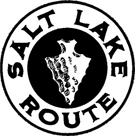Arden
Following conflicts between the San Pedro, Los Angeles & Salt Lake Railroad and the Union Pacific (see Caliente), the Union Pacific acquired a 50% interest in the former's Salt Lake Route. It is possible that Arden, a station on the line, was in turn named for UP executive E.H. Harriman's New York estate.
In early 1907, the Arden Plaster Company was formed to work gymsum deposits in the hills west of Arden, and a five-mile narrow gauge railroad was built to connect those deposits to a new mill built at Arden. It was plagued with intermittent difficulties, culminating in a fire which destroyed the mill in May 1912. It was rebuilt, and in July 1919 purchased by the U.S. Gypsum Company, which continued to operate until 1930.
Meanwhile, the Blue Diamond Corporation located their own gypsum deposit a few miles west of the Arden Co.'s in 1925. They built a mill at the deposits, to which the LA&SL constructed a 10½ mile standard-gauge line. Like the older narrow-gauge, it was plagued by difficulties. Though the Blue Diamond mill has continued to operate under different owners since then, the rail line was eventually truncated and now only serves as car storage.
The small Arden townsite, complete with a school, existed along the main line until the 1970s, and has since been overtaken by the rapid growth of Las Vegas. A water tower is the only remnant of the town, surrounded by modern industrial facilities and now used as a cellular tower, but traces of both old railroad grades can be found between the nearby housing tracts.














